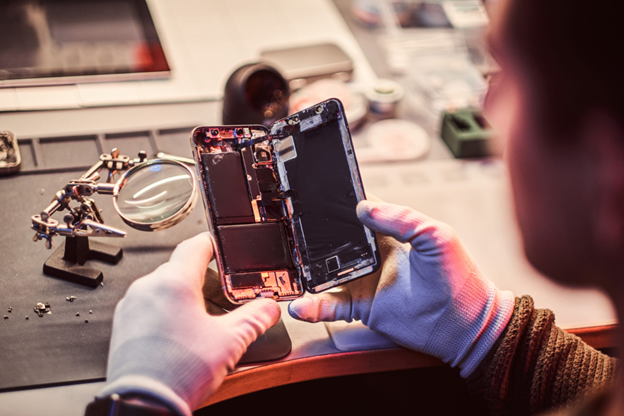Have you ever been in a situation where you wanted to shut down your repair business and go home?
There is no single reason for failure or customers leaving your repair store. When it comes to a competitive industry as cell phone repair, there is a lot at stake. You need to offer the best services in town, and also keep in mind the customer’s specific needs. While the significance of a cell phone store pos software is stressed throughout the sector, many businesses still use manual methods.
Here, we take a look at the practices that are letting you down as a repair business, and what you can change to get things back on track.
Using Low-Quality, Cheap Parts
Repair companies used to frequently rely on inexpensive parts to save money. As they grow more tech-savvy, however, customers are less willing to put up with the performance problems that frequently accompany subpar parts. Low-quality parts often wear out more quickly, requiring more repairs and resulting in a bad customer experience. Today’s customers choose long-lasting repairs that prolong the life of their gadgets over temporary solutions.
Repair companies can build confidence and a devoted clientele by putting quality before price. Purchasing premium, certified parts may result in a small up-front cost increase, but over time, it lowers customer complaints and improves brand reputation. Selecting trustworthy vendors and even collaborating with producers can assist in obtaining dependable components, strengthening the value provided to clients.
Also, here are 6 useful marketing techniques for cell phone repair shops.
Neglecting the Effect on the Environment
Consumers have been increasingly environmentally conscious in recent years, calling for green practices in all sectors of the economy. However, a lot of cell phone repair shops continue to ignore how their operations affect the environment. Numerous repair shops contribute significantly to environmental harm through the use of dangerous chemicals, plastic packaging, and e-waste. Ignoring these problems can drive away environmentally conscientious customers who actively look for sustainable products.
Repair companies must adopt eco-friendly procedures, such properly disposing of e-waste, using less plastic, and procuring eco-certified parts, in order to remain competitive. Promoting a circular economy strategy and implementing a program for recycling used parts can be excellent places to start. This not only benefits the environment but also appeals to an increasing number of customers who care about the environment. A repair company can differentiate itself from rivals mired in antiquated, unsustainable procedures by showcasing these activities on social media and on-site.
Providing Restricted Repair Services
Recent years have seen a significant advancement in cell phone technology, which now includes anything from sophisticated cameras to biometric security. However, a lot of repair shops still only offer simple screen or battery replacements, excluding intricate fixes that call for specialized knowledge and tools. Restricting services might drive away clients seeking specialist assistance in addition to reducing income potential.
Repair companies must broaden their services and skill set in order to thrive in a competitive market. Offering motherboard fixes, device refurbishing, or repairs for high-end models might open up new business niches. Purchasing cutting-edge equipment and providing technicians with continual training guarantees that the company can handle a wider variety of repairs. This growth makes repair shops more relevant in the market and draws in more clients by enabling them to operate as one-stop shops for a variety of client demands.
Concentrating Only on Walk-In Clients
Cell phone repair companies have relied on a consistent flow of local business for years, serving mostly walk-in clients. However, this strategy is becoming less viable as online shopping grows and consumer preferences shift. Nowadays, a lot of customers like digitally first experiences, such as scheduling repairs online, getting quotes, and remotely monitoring the repair procedure. Traditional repair shops risk falling behind if they don’t meet this digital need.
If repair shops wish to remain competitive, they must adopt a digitally friendly strategy. Customer reach can be greatly increased by putting in place an online booking system, enabling doorstep pickup and delivery, or even delivering video consultations.
Repair shops can reach a larger audience by developing a smooth digital experience, particularly with younger clients who place a high value on efficiency and convenience. Furthermore, an active social media presence and a well-designed website enhance brand awareness and engagement, enabling the company to reach a tech-savvy customer base.
Ignoring reviews and feedback from customers
In the era of social media and online reviews, a company’s reputation can be greatly influenced by its customers. Negative customer evaluations in particular might drive potential customers to competitors if they are ignored or handled improperly. Regretfully, several repair firms continue to downplay the significance of internet evaluations, losing out on insightful information and expansion prospects.
Customer feedback is an important tool for improvement for any modern cell phone repair company. Shops may increase customer loyalty and trust by keeping a close eye on reviews, effectively handling concerns, and putting recommended changes into practice. Promoting favorable reviews from pleased consumers on websites like Google or Yelp increases internet visibility and draws in new business. Converting consumer input into useful enhancements demonstrates the company’s appreciation for its clients and boosts its reputation in the marketplace.
Key Takeaways
Businesses who continue to use antiquated methods may find it difficult to compete in the rapidly changing cell phone repair market. Repair businesses need to put quality, sustainability, client interaction, and agility first if they want to survive in this future. They can establish a reputation for dependable repairs by making investments in premium parts and increasing their service offerings. Trust is further strengthened by emphasizing environmentally friendly procedures and effectively responding to consumer input, particularly as consumers’ concerns about sustainability and transparency develop.







